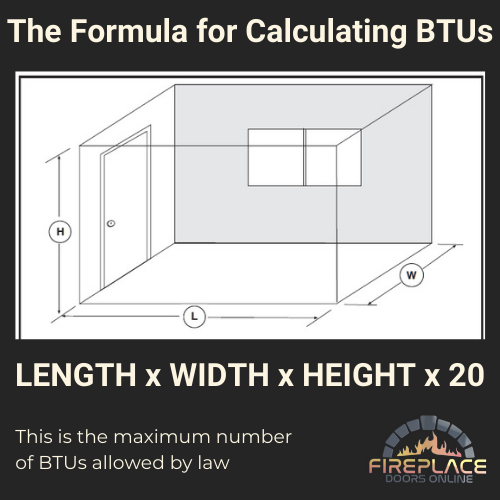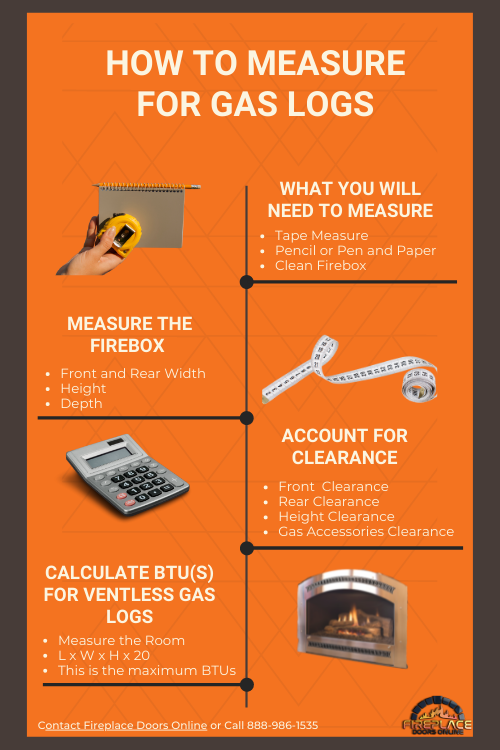How To Measure for and Choose a Gas Log Set
Whether you’re installing new gas fireplace logs or you’re shopping for replacement gas logs for an existing fireplace, choosing the best gas logs for your home starts with measuring. Gas logs come in various sizes and lengths, and they also need a certain amount of clearance on all sides of your firebox. This makes taking accurate measurements vital to understanding gas log options, and it ensures you’re choosing the right gas log set the first time around.
But, measuring your fireplace dimensions isn’t as easy as some people might think. You’ll want to measure your fireplace and firebox a certain way to avoid ordering the wrong set of gas logs and having to deal with returns or exchanges. To help, we’re going over how to measure for gas logs and choose the gas log set that’s right for you.
Gas Logs for Vented vs Ventless (Vent-Free) Gas Fireplaces
Two main types of fireplaces use gas logs – vented and ventless (vent-free). Understanding the difference between vented and ventless gas fireplaces will help you choose the best gas logs for your home. If you’re unsure about whether or not your fireplace is vented or ventless, here’s a quick overview of the different types of fireplaces for gas logs.
What Is a Vented Gas Fireplace?
Vented gas fireplaces have a chimney with a damper installed to allow air to flow up and out of the chimney. Vented fireplaces give you the option to use gas logs or real wood logs in your fireplace. A vented fireplace is also capable of handling both vented and ventless gas logs as long as you can close your chimney damper and you’re set up to burn gas. Many times, a vented gas fireplace is a wood-burning fireplace that has been converted to burn either natural gas or liquid propane gas (LPG).
What is a Ventless (Vent-Free) Gas Fireplace?
Ventless gas fireplaces don’t have a chimney with a damper and are generally used for heating purposes. A ventless fireplace means there is no chimney or damper for the heat to escape up, so it radiates back into the room where you’re burning ventless gas logs. You can only use ventless or vent-free gas logs in a ventless fireplace as they are not equipped with a chimney and damper to allow for proper airflow and exhaust.
How To Choose a Gas Log Set for Your Home: Heating vs Ambiance
To choose the best fireplace log set for your home, you’ll need to determine how you plan to use your fireplace gas logs and the purpose they’ll serve for your home. One of the first places to start is deciding whether you plan to use your gas logs for heating or ambiance. Decorative gas logs and gas logs for heating each have different fireplace and firebox clearance requirements.
For instance, do you want realistic fires and aren’t worried about heating capabilities, or do you want a gas log set that’s capable of heating a small space? Answering these questions will help you narrow down your choices and settle the vented vs ventless gas logs debate for yourself.
Vented vs Vent-Free Gas Logs
Vented gas logs emit smoke and other byproducts as a result of burning while ventless gas logs are smoke-free and highly fuel-efficient. Vented gas logs offer a more realistic fire in your fireplace and ventless gas logs are designed to help supplement heating. Understanding the difference between vented and vent-free gas logs as well as the difference between types of gas fireplaces will help narrow down your choices so you can buy the perfect log set to meet your needs.
Whether or not to use vented or unvented gas logs depends on personal preferences and the type of fireplace you have. Regardless of the type of gas fireplace logs you go with, you’ll still need to take certain measurements before you’re able to choose the right size logs.
How to Measure a Fireplace and Firebox for Gas Logs
To measure your fireplace and firebox for gas logs, you need to measure four areas – front width, rear width, depth and height. The height of your firebox is measured from bottom to top, and the depth is measured from front to back. Regardless of the type of fireplace doors you have or the style of hearth that exists, the size of your firebox determines what size gas logs you will need. You’ll need to measure your firebox and also account for clearances, which we’ll get into a little later.
Gather and prepare the following items to accurately measure your fireplace’s firebox:
-
Easy-to-read tape measure
-
Pencil or pen and paper
-
Clean and empty fireplace and firebox
Once you have your firebox cleaned out and free of ashes or debris, you’ll also want to move all of your fireplace accessories such as your log grate and hearth tools out of the way. You want a free and clear firebox for measuring. Now, it’s time to break out your tape measure, pencil and notepad to start measuring your firebox.
We’ve included a diagram to help you accurately identify the four areas to measure in your firebox.
.png?1648651454432)
You’ll need to take these four measurements in your firebox to accurately choose a gas log set that will work in your gas-burning fireplace. If you have a prefabricated or zero-clearance fireplace, it’s important to know that the design of your firebox starts further back where the firewalls begin. To help you save time while measuring for your new gas logs, also be sure to write down each measurement as you go and double-check your numbers.
.png?1648651509338)
Measuring and Accounting for Firebox Clearances
To keep your gas log set performing at a high level, you need to have a certain amount of clearance on all sides of your gas logs. Gas logs need a certain amount of room to operate and function properly in your firebox. This space that’s accounted for when sizing gas logs is known as clearance.
Some of the firebox clearances to keep in mind as you choose a new gas log set include:
-
Front width: the front width of your firebox needs to have 2-6 inches of clearance on both sides of the gas log set. This allows for proper airflow and room for your gas logs to operate.
-
Rear width: the rear width of your firebox needs to be at least as long as your gas logs. For example, if your gas log set is 18 inches, then the rear width measurement of your firebox needs to be at least 18 inches.
-
Height: most sets of gas logs need a minimum height of 18 inches to fit and operate as they’re designed to in your firebox. It’s important to account for properly stacking gas logs and the size of the flames.
-
Gas fireplace accessories: gas logs need additional clearance from gas fireplace accessories such as safety pilot lights, remote control or millivolt systems and burner systems. Allow 3 inches on each side of your gas logs for pilot lights and 6 inches on each side for remote control gas logs.
Having enough room on all sides of your gas logs ensures they’re working properly and lasting you for years to come. The last thing you want is to order the wrong log set for your gas fireplace and have to deal with the hassles of returns or exchanges.
Now that you have your firebox measurements written down and double-checked, it’s just about time to start pairing your existing fireplace’s dimensions with different gas log sizes.
Gas Log Sizing Chart
To help you find the right size gas logs to fit your fireplace, we’ve included a gas log sizing chart to reference. Now that you have your firebox measured, and you’ve accounted for clearance to help your gas logs work like they’re designed to, it’s time to start sizing gas logs using our sizing chart to help guide your decision.
|
Gas Log Size |
Firebox Front Width |
Firebox Rear Width |
Firebox Depth |
Firebox Height |
|---|---|---|---|---|
|
12 Inches |
16-24 Inches |
12 Inches Minimum |
12-14 Inches |
18 Inches |
|
13 Inches |
17-25 Inches |
13 Inches Minimum |
12-14 Inches |
18 Inches |
|
15 Inches |
19-27 Inches |
15 Inches Minimum |
12-14 Inches |
18 Inches |
|
16 Inches |
20-28 Inches |
16 Inches Minimum |
12-14 Inches |
18 Inches |
|
17 Inches |
21-29 Inches |
17 Inches Minimum |
12-14 Inches |
18 Inches |
|
18 Inches |
22-30 Inches |
18 Inches Minimum |
12-14 Inches |
18 Inches |
|
19 Inches |
23-31 Inches |
19 Inches Minimum |
12-14 Inches |
18 Inches |
|
20 Inches |
24-32 Inches |
20 Inches Minimum |
12-14 Inches |
18 Inches |
|
21 Inches |
25-33 Inches |
21 Inches Minimum |
12-14 Inches |
18 Inches |
|
22 Inches |
26-34 Inches |
22 Inches Minimum |
12-14 Inches |
18 Inches |
|
24 Inches |
28-36 Inches |
24 Inches Minimum |
12-14 Inches |
18 Inches |
|
26 Inches |
30-38 Inches |
26 Inches Minimum |
12-14 Inches |
18 Inches |
|
30 Inches |
34-42 Inches |
30 Inches Minimum |
12-14 Inches |
18 Inches |
|
36 Inches |
40-48 Inches |
36 Inches Minimum |
12-14 Inches |
18 Inches |
If you’re looking at ventless gas logs for your gas fireplace, then you’ll need to make a few extra considerations. Ventless logs are designed for heating, so these types of gas fireplace logs are rated the same way as space heaters and other heating devices.
How To Measure for Ventless (Vent-Free) Gas Logs
To measure for ventless gas logs in your home, you’ll need to figure out the area of the room where they’ll be used. Measuring your fireplace and firebox for ventless gas logs is certainly more involved than measuring for vented gas logs.
Since vent-free gas logs are designed to be used in heater-rated fireplaces, you’ll need to determine the maximum amount of British Thermal Units (BTUs) of the room where you plan to use your logs.
Here is the formula for measuring the maximum number of BTUs allowed in a room:

Let’s say your room is 1,400 square feet. When you multiply 1,400 by 20, you get 28,000. This is the maximum number of BTUs for that room, and you’ll want to shop for ventless gas logs with BTU ratings of 28,000 or lower. Once you’ve determined the area of the room and multiplied that number by 20, you’ll have the maximum amount of BTUs legally allowed in the room where you’re planning to install ventless logs.
It’s important to note that bathrooms, bedrooms and other small spaces aren’t legally allowed to have a heating appliance over 10,000 BTUs installed. Likewise, ventless gas logs are not recommended for anyone suffering from allergies, asthma or other conditions that cause trouble breathing.
Fireplace Doors Online Carries Vented and Ventless Gas Log Sets
Now that you know which type of log you need and how to measure your fireplace, firebox and rooms for new gas logs, it’s time to start shopping for new log sets.
Fireplace Doors Online carries a variety of both vented and ventless gas log sets from all of the top brands including RealFyre, Grand Canyon, R.H. Peterson and more! We can even help you pair your new logs with decorative gas log accessories that will transform your fireplace into a unique, one-of-a-kind feature.
Need help placing an order or finding the right size gas logs for your home? Contact us online or give us a call at 888-986-1535 and a member of our team will be happy to help!
No posts found







